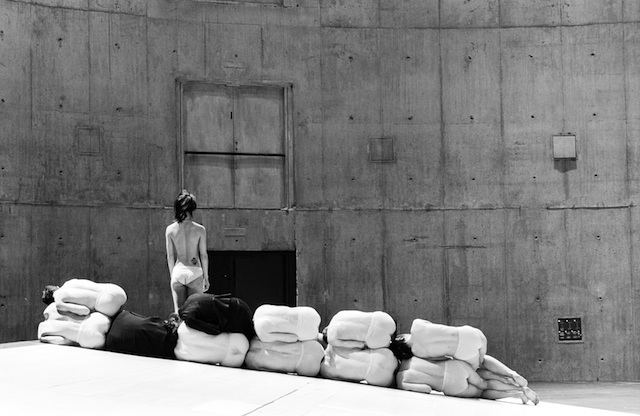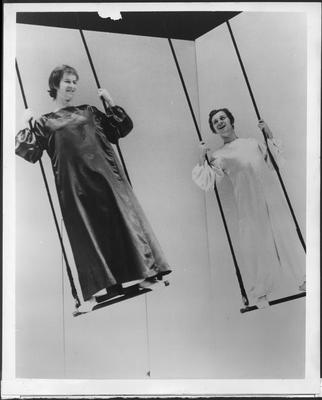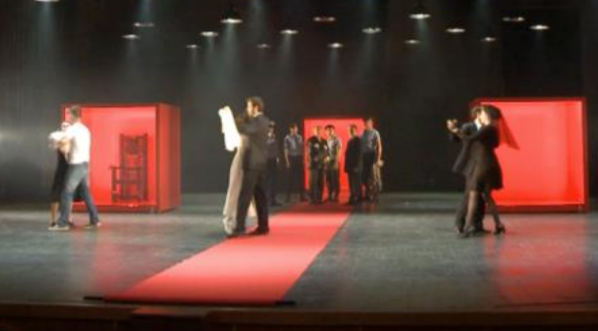by Linda McJannet
Many people are familiar with ballet and modern dance adaptations of Shakespeare’s plays, but some theatre practitioners have made the case for integrating dance throughout a performance of the text in a style known as physical theatre. While the term is sometimes applied to modern-dance-like versions that use only movement to convey the essential elements of plot and character, physical theatre usually refers to the marriage of spoken text and movement, a marriage that arose from revolutionary movements in both dance and theatre in the mid-twentieth century.
According to Sabine Sörgel, influenced by the traumas of World War II and the branch of philosophy known as phenomenology, Western theatre practitioners began to rely less upon “the word” and more on pre-conceptual experience and the actor’s body (Sörgel 91). Similarly, German choreographer Pina Bausch pioneered tanstheatre (dance-theatre), partly in a response to the genocides of the war and the signing of the Universal Declaration of Human Rights in 1948. Bausch’s work celebrated movement trouvé (found movement) and the activities of ordinary (peacetime) life, such as walking, carrying babies, caressing—or gently brushing someone’s hair (Shevtsova 9-11). Later, Sasha Waltz focused on the body itself. In her breakthrough work, Körper (Bodies), a group of half-naked dancers recalled images from the Nazi death camps, and beautifully sculpted torsos resembled rows of sandbags (see Fig. 1). These images remind us simultaneously of the body’s beauty and its vulnerability.

Fig. 1. Sasha Waltz, Körper (Bodies), 2000. Photo Bernd Uhlig.
At about the same time, avant garde theatre directors, such as Antonin Artaud, Jacques Lecoq, and Jerzy Grotowski laid the foundations for physical theatre. Like dance theatre, physical theatre values many kinds of movement, including the quotidian, and views the body as “a story-telling machine.” As Enrique Pardo put it, both genres seek to reach “a promised land where literature and the physical body might meet, enhance each other’s possibilities, and yield more complex images than [each might do alone]” (Pardo 19). Physical theatre also draws on commedia dell arte, in which the actor is an improviser, dancer, and acrobat and on stylized Asian traditions, such as Japanese Noh drama (Callery 11).
Many physical theatre practitioners were inspired by Grotowski’s ideal of “poor theatre,” which was popularized by Peter Brook in The Empty Space (1968). Brook’s celebrated production of A Midsummer Night’s Dream (1970), sometimes known as “the circus Midsummer,” is arguably the first well known Shakespearean example of physical theatre. The actors swung on trapezes, balanced spinning plates, and walked on stilts (see Fig. 2). The trapezes had the effect of altering the “theatrical contract”: as Brook put it, “When a man flies over the audience’s head on a rope, every aspect of the immediate is put in jeopardy” (52).

Fig. 2. Oberon and Puck in Peter Brook’s
A Midsummer Night’s Dream (1970).
Photo: Royal Shakespeare Company.
Grotowski sought to purge the theatre of superfluous spectacle and focused on the actor as “the core of theatre art” (15). Grotowski’s goal was to harness the body as a vehicle of emotional expression, not to train it for physical feats per se. As American observer of Grotowski’s lead actor explained, “There was something in his face . . . that removed the work entirely from the world of gymnastics. It was as if the enormous muscular energy we witnessed was . . . the emanation of an even more intense inner life (Wangh xix). Grotowski’s disciples today do not follow all of his precepts, particularly his strictures against lighting and music, but they all seek to explore the expressive power of the actor’s body.
Many physical theatre companies rely on “found texts” or write their own, but a surprising number have turned to classic works, including Shakespeare. Of the thirteen ensembles featured in a recent article by K.C. Wright in Backstage, six have produced one or more of Shakespeare’s plays. (See Physical Theatre Shakespeare Productions.) The internationally acclaimed productions of Cheek by Jowl, led by director Declan Donnellan and designer Nick Ormerod, increasingly incorporate dance (a tango in As You Like It, waltzes in Measure for Measure) and choreographed movement for the entire company to propel the action, heighten emotion, and manage entrances, exits, and scene changes (see Fig. 3).

Fig 3. The waltz in the closing minutes of Cheek by Jowl’s Measure for Measure (2015).
Physical theatre versions of the plays speak to the perhaps unacknowledged needs of contemporary audiences, many of whom are wedded to a digital world in which risk is illusory, presence is virtual, and the intimacy between performer and spectator is reduced to pixels on a screen. In addition, despite (or rather because of) their playfulness, they engage audiences with the plays’—and our time’s—most serious themes: war, the abuse of power, and the plight of refugees. They succeed in part because they accentuate elements already present in Shakespeare’s dramatic art. They physicalize the text, mingle comic and tragic, and pivot among different media and registers of performance.
© Linda McJannet, 2019.
Works Cited
Brook, Peter. The Empty Space: A Book about the Theatre: Deadly, Holy, Rough, Immediate. New York: Touchstone Books, 1968.
Callery, Dymphna. Through the Body: A Practical Guide to Physical Theatre. New York: Routledge, 2001.
Grotowski, Jerzy. Towards a Poor Theatre. Edited by Eugenio Barba, preface by Peter Brook (1968). Rept. New York: Routledge, 2002.
McJannet, Linda. “Incorporating the Text: John Farmanesh-Bocca’s Pericles Redux and Crystal Pite’s The Tempest Replica.” In The Oxford Handbook of Shakespeare and Dance, ed. Lynsey McColloch and Brandan Shaw, pp. 545-568. New York: Oxford University Press, 2019.
_____. “Embodying the Sea: Shakespeare and Physical Theatre.” In Shakespeare on Stage and Off, ed. Kenneth Graham and Alysia Kolentsis, pp. 76-88. Toronto: McGill-Queen’s University Press, 2019.
Pardo, Enrique. “The Angel’s Hideout: Between Dance and Theatre.” Performance Research 3, no. 2 (1998): 19-26.
Sanchez-Colberg, Ana. “Altered States and Subliminal Spaces: Charting the Road towards a Physical Theatre.” Performance Research 1, no. 2 (1996): 40-56.
Sörgel, Sabine. Dance and the Body in Western Theatre: 1948 to the Present. London: Palgrave, 2015.
Shevtsova, Maria. “Performance, Embodiment, Voice: The Theatre/Dance Cross-overs of Dodin, Bausch, and Forsythe,” NTQ (New Theatre Quarterly) 19, no. 1 (February 2003): 5-17.
Wangh, Stephen. An Acrobat of the Heart: A Physical Approach to Acting Inspired by the Work of Jerzy Growtowski. New York: Vintage Books, 2000.
Wright, K.C. “13 Innovative Physical Theatre Companies,” Backstage, Nov. 4, 2014. https://www.backstage.com/magazine/article/innovative-physical-theater-companies-10279/.
Citation:
McJannet, Linda. “Shakespeare and Physical Theatre.” The Shakespeare and Dance Project, edited by Linda McJannet, Amy Rodgers, and Emily Winerock, November 16, 2019. shakespeareandance.com/articles/shakespeare-and-physical-theatre. Accessed [date].
Updated November 16, 2019.
2013-2024. All rights reserved. The Shakespeare and Dance Project.